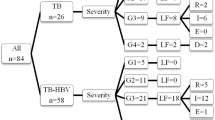Summary
Hepatitis associated anti-tuberculous treatment (HATT) has been a main obstacle in managing patients co-infected with Mycobacterium tuberculosis and hepatitis B virus (HBV). Therefore, we evaluated the factors related to the severity of adverse effects during HATT, especially those associated with liver failure. A retrospective study was carried out at Tongji Hospital from 2007 to 2012. Increases in serum transaminase levels of >3, 5, and 10 times the upper limit of normal (ULN) were used to define liver damage as mild, moderate, and severe, respectively. Patients with elevated total bilirubin (TBil) levels that were more than 10 times the ULN (>171 μmol/L) with or without decreased (<40%) prothrombin activity (PTA) were diagnosed with liver failure. A cohort of 87 patients was analyzed. The incidence of liver damage and liver failure was 59.8% (n=52) and 25.3% (n=22), respectively. The following variables were correlated with the severity of hepatotoxicity: albumin (ALB) levels, PTA, platelet counts (PLT), and the use of antiretroviral therapies (P<0.05). Hypo-proteinemia and antiretroviral therapy were significantly associated with liver failure, and high viral loads were a significant risk factor with an odds ratio (OR) of 2.066. Judicious follow-up of clinical conditions, liver function tests, and coagulation function, especially in patients with high HBV loads and hypoalbuminemia is recommended. It may be advisable to reconsider the use of antiviral drugs failure during the course of anti-tuberculous treatment of HBV infection patients to avoid the occurrence of furious liver failure.
Similar content being viewed by others
References
Devarbhavi H, Singh R, Patil M, et al. Outcome and determinants of mortality in 269 patients with combination anti-tuberculous drug-induced liver injury. J Gastroenterol Hepatol, 2013,28(1): 161–167
Park WB, Kim W, Lee KL, et al. Antituberculosis drug-induced liver injury in chronic hepatitis and cirrhosis. J Infection, 2010,61(4): 323–329
Chien JY, Huang RM, Wang JY, et al. Hepatitis C virus infection increases hepatitis risk during anti-tuberculous treatment. Int J Tuberc Lung Dis, 2010,14(5): 616–621
Pande JN, Singh SPN, Khilnani GC, et al. Risk factors for hepatotoxicity from antituberculosis drugs: a case-control study. Thorax, 1996,51(2): 132–136
Pan L, Jia ZS, Chen L, et al. Effect of anti-tuberculous therapy on liver function of pulmonary tuberculosis patients infected with hepatitis B virus. World J Gastroenterol, 2005,11(16): 2518–2521
Yew WW, Leung CC. Antituberculosis drugs and hepatotoxicity. Respirology, 2006,11(6): 699–707
Blumberg HM, Burman WJ, Chaisson RE, et al. American Thoracic Society, Centers for Disease Control and Prevention and Infectious. Diseases Society of America: Treatment of Tuberculosis. Am J Respir Crit Care Med, 2003,167(4): 603–662
Wong WM, Wu PC, Yuen MF. Antituberculosis drug-related liver dysfunction in chronic hepatitis B infection. Hepatology, 2000,31(1): 201–206
Wang JY, Liu CH, Hu FC, et al. Risk factors of hepatitis during anti-tuberculous treatment and implications of hepatitis virus load. J Infection, 2011,62(6): 448–455
Singla R, Sharma SK, Mohan A, et al. Evaluation of risk factors for antituberculosis treatment induced hepatotoxicity. Indian J Med Res, 2010,132(6): 81–86
Anand AC, Seth AK, Paul M, et al. Risk factors of hepatotoxicity during anti-tuberculosis treatment. Med J Armed Forces India, 2006,62(1): 45–49
Sun HY, Chen IL, Gau CS, et al. A prospective study of hepatitis during antituberculous treatment in Taiwanese patients and a review of the literature. J Formos Med Assoc, 2009,108(2): 102–111
Tostmann A, Boeree MJ, Aarnoutse RE, et al. Antituberculosis drug-induced hepatotoxicity: Concise up-to-date review. J Gastroenterol Hepatol, 2008,23(2): 192–202
Cai Y, Yi JY, Zhou CH, et al. Pharmacogenetic Study of drug-metabolising enzyme polymorphisms on the risk of anti-tuberculous drug induced liver injury: A meta-analysis. Plos One, 2012,7(10):e47769
Author information
Authors and Affiliations
Corresponding author
Additional information
This project was supported in part by the Organization Department of the Central Committee of the Communist Party of China 2015 “sunshine of the west” visiting scholar program (No. 2903).
Rights and permissions
About this article
Cite this article
Zhu, Ch., Zhao, Mz., Chen, G. et al. Baseline HBV load increases the risk of anti-tuberculous drug-induced hepatitis flares in patients with tuberculosis. J. Huazhong Univ. Sci. Technol. [Med. Sci.] 37, 105–109 (2017). https://doi.org/10.1007/s11596-017-1702-3
Received:
Revised:
Published:
Issue Date:
DOI: https://doi.org/10.1007/s11596-017-1702-3




